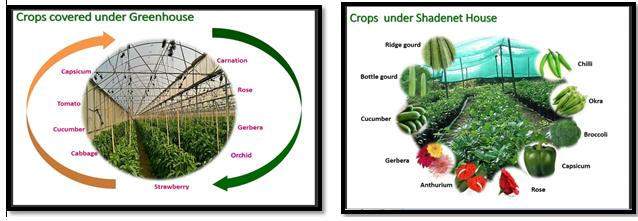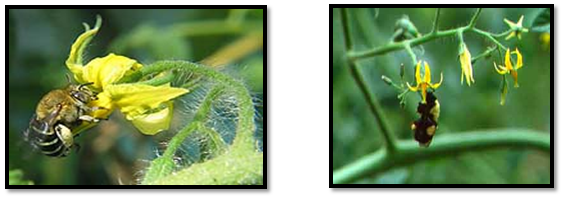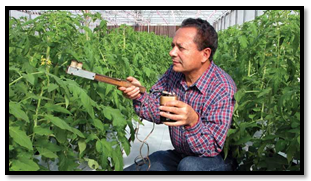Authors: Bhakti B. Panchal, Dr. N. B. Patel and Dr. Sanjeev Kumar
Department of Vegetable Science,
ASPEE College of Horticulture and Forestry, Navsari Agricultural University,
Navsari-396450
bhakti.b.panchal@gmail.com
Why protected cultivation ?
• Better quality produce
• Higher productivity
• Off-season cultivation
• Better insect-pest and disease management
• Efficient use of resources
• Reduced used in pesticides
• Higher profitability

Regulation of flowering and fruiting in tomato
Flowers
• Normally the flower clusters are not pruned until 3 to 4 well-formed fruit appears on that cluster.
• However, abnormal flowers (the large fascinated flower) have to be removed as soon as recognized. This flower will produce a cat-faced fruit.
Terminal points
• Remove the terminal growing point above the top flower cluster (last cluster to pollinate) approximately forty five days before the intended date of terminating the tomato crop to stop plants from continuing to grow.
• Leave 2-3 leaves above the top cluster to shade and feed the top fruits.
• During hot summer months and leaving as many leaves on the plant can provide good shade for the growing fruit and cool the greenhouse.
• It is estimated that each plant will transpire close to 1-1.5 lit. of water a day and a house full of plants can lower the temperature of the greenhouse by at least 10 °F.
Pollination
• The female organs of the tomato flower are enclosed inside the male organs (five anthers attached together to form a cone around the female organ). Anthers open to the inside releasing pollen as soon as they mature.
• At maturity, the anthers will have a bright yellow colour and the flower will be receptive to pollination for about 48 hours.
• Pollen released without vibrating the flower will not be sufficient to produce high yield of good quality fruit. Field tomatoes are pollinated (vibrated) by natural wind.
• Because natural wind is absent in the greenhouse, tomato growers must pollinate their crop by several means including battery operated vibrators, air blowers, and bumblebees.
• Growers should also make every effort to transfer the maximum number of pollen to the stigma of the flower.
• The size and weight of the tomato fruit is positively correlated with the number of pollen transferred to the female part of the flower.

Battery operated vibrators
• Vibrators are small devices which can be purchased from any greenhouse supply store and operated by a weak electrical current from a battery.
• Vibrate the flowers by touching the stem of the flower cluster for few seconds. The strong vibration created by this tool will release more than enough pollen to fertilize the majority of the eggs in the ovary.
• Pollinate the flowers every-other-day on sunny days when humidity in the greenhouse is between 60 and 80%.
• Touch the cluster stem and do not touch the flower itself otherwise a hole will be created in the developing fruit. It takes approximately 30 minutes three times a week to pollinate 700 plants in one greenhouse of size 30X96 feet.
• This method of pollination is good for a small-size operation and the best method to guarantee pollinating every flower you want to pollinate and produce maximum-size fruit.
• Some of the drawback includes the fact that a grower has to be in the greenhouse at a certain time three times a week, it is a boring job, and the possibility of producing fruit with holes if you touch the flower.

Air blowers
• Greenhouse tomatoes can be pollinated by using a household leaf blower operated at normal speed with the air flow directed to the flower clusters.
• Use this device three times a week.
• It takes half the time to pollinate the same number of plants compared to the electric vibrator.
• However, the number of seed per fruit was less and fruit size and weight were smaller than fruit produced by using the vibrator for pollination.
• In general, anticipate five percent reduction in yield if you use this device.
Bumblebees
• Using bees to pollinate one or two greenhouses will save you time to do something else but it will not save money.
• Bumblebees are excellent pollinators for greenhouse tomatoes. Each bee will visit and vibrate the flower for few seconds to collect pollen for feeding. As a by product of this process, the stigma of the flower is showered with a large number of pollen leading to good pollination and fertilization of almost all the eggs in the ovary.
• Larger size and a heavier fruit is expected from bee pollination. Bees are active from sunrise to sunset, they do not take a long break or a day off.
• It is estimated that each bee can pollinate up to 350 flowers.
• Using a hive (even the smallest mini-hive) can lead to over pollination and injuring many flowers in a small greenhouse.
• Bumble bee box in polyhouse
Using of growth regulators
• The growth regulators can be used to increase fruit set at high and low temperature to reduce the leaf curl incidence.
• The flower dipping in PCPA (Parachloro-Phenoxy acetic acid) 30 ppm at the fully open stage to increase the fruit set at low and high temperature.
• The application of Cycocel (500ppm) on the plants in nursery 3-4 days before transplanting another spray of it 25-30 days after transplanting.
• It reduces the leaf curl incidence.
Chemicals which used for fruit development
| Chemicals | Common name | Dose (mg/l) | Effective |
| 2-Chloroethylphosponic acid | Ethephon | 200-500 whole plant spray | Flowering induction, better rooting and setting of plants |
| 2,4 Dichlorophenoxy acetic acid | 2,4-D | 2-5 as seed treatment or whole plant spray | Increase fruit set, earliness and parthenocarpy |
| 3- Indole Butyric acid | IBA | 50-100 | Increase fruit set |
| 3 Indole acetic acid | IAA | Foliage spray | For good fruit size and yield |
Regulation of flowering and fruiting in capsicum
Flowering
• A young capsicum plant starts flowering about two to six weeks after planting, when it has 7 to 13 leaves.
• The optimal temperature during flowering should be 20 - 21oC on average both day and night.
• A low night temperature decrease pollen viability in capsicum flowers and modify flower structure and makes self pollination less effective.
• Flowers developed at a night temperature below 18°C usually produce a fruit with a ‘tail’ (elongated, pointing blossom-end).
• A lower temperature during flowering results in less four-loculed fruit, and more three loculed fruit, or even two-loculed fruit, which is not desired.
• A flower grown under very low temperature (below 10oC at night) would produce a small flattened fruit.
• Too high temperature (> 28 °C) stimulate blossom end rot.
Pollination
• To ensure the set of high quality fruits use pollinators like bumble bees or honey bees inside the greenhouse.
• Bees make that less fruit are deformed, and that fruit set and first harvest are better and a bit earlier.
Fruit set
• High light and low day temperature are beneficial for setting and first growth of the new fruit.
• The total period from blossom to full-colour ripe fruit is 7 - 12 weeks. When fruit set is difficult)
• Drop the night temperature to 18°C. The day temperature can stay at 20-22°C.
• Increase the CO2 concentration (to 700-1000 ppm).
• For setting of the second flush of capsicum fruit, dropping the temperature is not advised, as it will slow down the ripening of the first flush.
• Generally the later fruits will set by themselves after harvest of older fruits.
Controlling fruit load
• Young plants can support about four to eight fruit per plant at a time.
• An older crop can have over 10 fruits per plant at a time.
• Fruit load must be controlled by the grower, in order to achieve a reasonable fruit weight (e.g. minimal 150 gram per fruit) and quality.
• The best method to correct the number of fruit is by removing excess.
Regulation of flowering and fruiting in cucumber
• A fruit may develop at each node and more than one may begin to develop at some nodes.
• It is usually best to thin these multiple-fruit clusters to a single fruit; however, vigorous plants can sometimes have more than one cucumber at a node and any distorted fruit should be removed immediately.
• The greatest growth of the fruit occurs between day 6 and 14 after the bloom opens (anthesis). Maximum fruit length occurs at day 14 followed by diameter increase.
• The shape of the fruit is somewhat tapering at the stem end prior to day 10 after the bloom, however, the fruit becomes uniformly cylindrical by day 14.
• During the spring season, commercially acceptable fruit size is usually reached by the 11th day after the bloom opens.
Conclusion
For the setting of fruits inside greenhouse or protected cultivation various techniques are used. From forgoing discussion, mostly in tomato at high humidity condition mostly use the blowers and PGRs for setting of fruits. And these situation 95-100 % results were taken on our university farm. Generally in cucumber used the gynodioesious/ parthenocarpic hybrids. But, sometimes by hand emasculation pollination of flowers was done; it’s less chance to set a uniform fruits and time consuming.
References
1. http://www.jains.com/Protected%20Cultivation/protectedcultivation.htm
2. http://www.jnkvv-vegsoft.com/english/protected_cultivation_tech.php?vegid=3
3. http://midh.gov.in/PDF/midhPPT10.pdf
About Author / Additional Info:
Ph. D. (Horticulture) Scholar